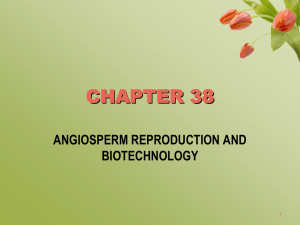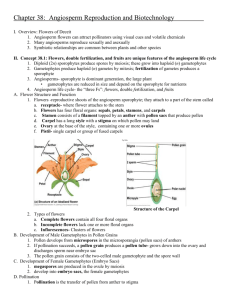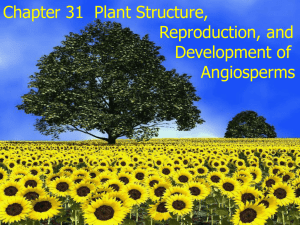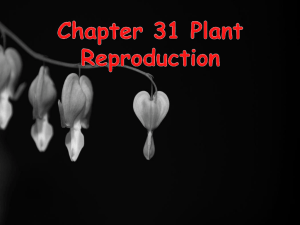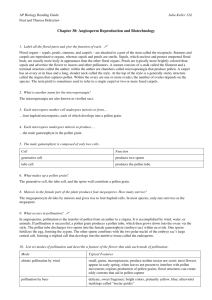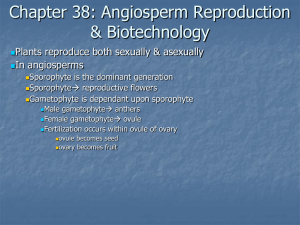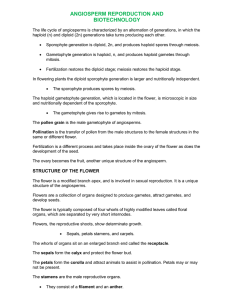CHAPTER 38 : ANGIOSPERM REPRODUCTION AND
advertisement
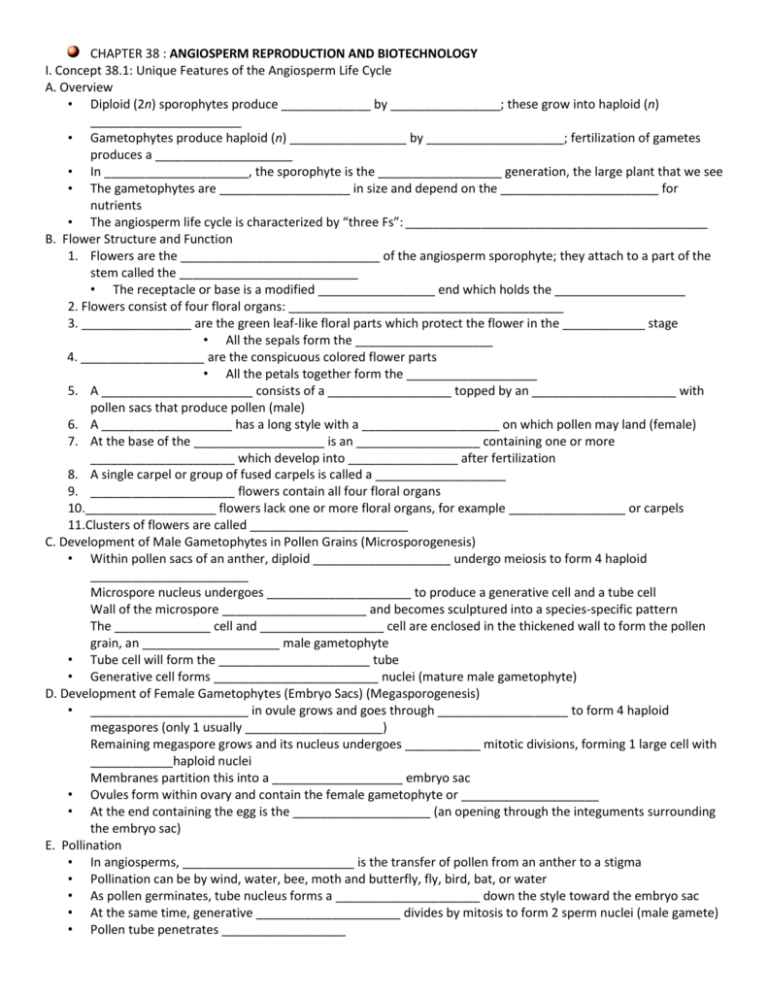
CHAPTER 38 : ANGIOSPERM REPRODUCTION AND BIOTECHNOLOGY I. Concept 38.1: Unique Features of the Angiosperm Life Cycle A. Overview • Diploid (2n) sporophytes produce _____________ by ________________; these grow into haploid (n) ______________________ • Gametophytes produce haploid (n) _________________ by ____________________; fertilization of gametes produces a ____________________ • In _____________________, the sporophyte is the __________________ generation, the large plant that we see • The gametophytes are ___________________ in size and depend on the _______________________ for nutrients • The angiosperm life cycle is characterized by “three Fs”: ____________________________________________ B. Flower Structure and Function 1. Flowers are the _____________________________ of the angiosperm sporophyte; they attach to a part of the stem called the __________________________ • The receptacle or base is a modified _________________ end which holds the ___________________ 2. Flowers consist of four floral organs: ________________________________________ 3. ________________ are the green leaf-like floral parts which protect the flower in the ____________ stage • All the sepals form the ____________________ 4. __________________ are the conspicuous colored flower parts • All the petals together form the ___________________ 5. A ______________________ consists of a __________________ topped by an _____________________ with pollen sacs that produce pollen (male) 6. A ___________________ has a long style with a ____________________ on which pollen may land (female) 7. At the base of the ___________________ is an __________________ containing one or more _____________________ which develop into ________________ after fertilization 8. A single carpel or group of fused carpels is called a ___________________ 9. _____________________ flowers contain all four floral organs 10.___________________ flowers lack one or more floral organs, for example _________________ or carpels 11.Clusters of flowers are called _______________________ C. Development of Male Gametophytes in Pollen Grains (Microsporogenesis) • Within pollen sacs of an anther, diploid ____________________ undergo meiosis to form 4 haploid _______________________ Microspore nucleus undergoes _____________________ to produce a generative cell and a tube cell Wall of the microspore _____________________ and becomes sculptured into a species-specific pattern The ______________ cell and __________________ cell are enclosed in the thickened wall to form the pollen grain, an ____________________ male gametophyte • Tube cell will form the ______________________ tube • Generative cell forms ________________________ nuclei (mature male gametophyte) D. Development of Female Gametophytes (Embryo Sacs) (Megasporogenesis) • _______________________ in ovule grows and goes through ___________________ to form 4 haploid megaspores (only 1 usually ____________________) Remaining megaspore grows and its nucleus undergoes ___________ mitotic divisions, forming 1 large cell with ____________haploid nuclei Membranes partition this into a ___________________ embryo sac • Ovules form within ovary and contain the female gametophyte or ____________________ • At the end containing the egg is the ____________________ (an opening through the integuments surrounding the embryo sac) E. Pollination • In angiosperms, _________________________ is the transfer of pollen from an anther to a stigma • Pollination can be by wind, water, bee, moth and butterfly, fly, bird, bat, or water • As pollen germinates, tube nucleus forms a _____________________ down the style toward the embryo sac • At the same time, generative _____________________ divides by mitosis to form 2 sperm nuclei (male gamete) • Pollen tube penetrates __________________ F. Double Fertilization • After landing on a __________________ stigma, a pollen grain produces a pollen tube that extends between the cells of the style toward the __________________ • __________________________ results from the discharge of two sperm from the pollen tube into the embryo sac • One sperm fertilizes the ___________________, and the other combines with the polar nuclei, giving rise to the triploid (3n) food-storing _____________________ • After double fertilization, each ovule develops into a ___________________ • The ovary develops into a ___________________ enclosing the seed(s) G. Seed Development, Form and Function 1. Endosperm Development • _____________________ development usually precedes embryo development • In most monocots and some eudicots, endosperm stores ___________________ that can be used by the ___________________ • In other eudicots, the food reserves of the endosperm are exported to the ____________________ 2. Embryo Development • The first mitotic division of the zygote is ____________________, splitting the fertilized egg into a basal cell and a terminal cell 3. Structure of the Mature Seed • The embryo and its food supply are enclosed by a hard, protective ___________________ • The seed enters a state of ____________________ • In some eudicots the embryo consists of the embryonic axis attached to ______________________ (seed leaves) • Below the cotyledons the embryonic axis is called the ___________________ and terminates in the ______________________ (embryonic root); above the cotyledons it is called the ___________________ (shoot tip with a pair of miniature leaves) • A monocot embryo has _________________________ • Grasses, such as maize and wheat, have a special cotyledon called a __________________________ which absorbs nutrients from the endosperm during germination • Two sheathes enclose the embryo of a grass seed: a _____________________ covering the young shoot and a __________________ covering the young root 4. Seed Dormancy • Seed dormancy increases the chances that ______________________ will occur at a time and place most ________________________ to the seedling • The breaking of seed dormancy often requires ________________________ cues, such as _____________________ or lighting changes 5.Seed Germination and Seedling Development • Germination depends on ______________________, the uptake of water due to low water potential of the dry seed • The __________________ (embryonic root) emerges first • Next, the ___________________ breaks through the soil surface • In many eudicots, a hook forms in the ________________________, and growth pushes the hook above ground • The ____________________ straightens and pulls the cotyledons and shoot tip up • In maize and other grasses, which are monocots, the _________________________ pushes up through the soil H. Fruit Form and Function 1. A _____________________ develops from the ovary 2. It protects the enclosed seeds and aids in _____________________ by wind or animals 3. A fruit may be classified as ___________________, if the ovary dries out at maturity, or ________________, if the ovary becomes thick, soft, and sweet at maturity 4. Fruits are also classified by their development: -_________________, a single or several fused carpels -____________________, a single flower with multiple separate carpels -______________________, a group of flowers called an inflorescence 5. An _______________________ fruit contains other floral parts in addition to ______________________ 6. Fruit dispersal mechanisms include: ___________________________ II. Concept 38.2: Plants Reproduce Sexually, Asexually, or Both A. Asexual reproduction, or vegetative reproduction, produces ________________________. B. Mechanisms of Asexual Reproduction 1. ______________________ is an example in which pieces of the parent plant break off to form new individuals that are exact genetic replicas of the parent. 2. ____________________ is the asexual production of seeds from a diploid cell. (Ex: dandelions) C. _________________________ uses several techniques of artificial vegetative reproduction such as grafting, growing clones from cuttings, and test-tube cloning D. Asexual reproduction can be ____________________ to a successful plant in a ______________ environment E. Sexual reproduction generates ___________________________ that makes evolutionary adaptation possible F. While some flowers ______________________, other have methods to _________________ self-fertilization and ___________________ genetic variation. • One of these is _________________________________, in which a plant _______________________ its own pollen or that of a closely related plant, thus insuring ___________________________



